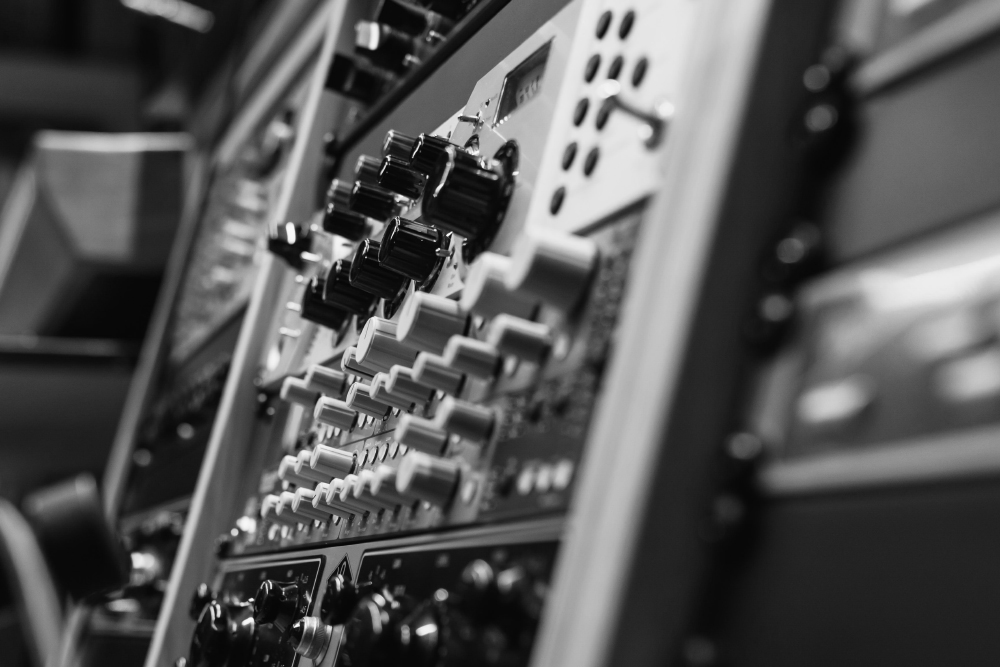
Because of an acoustic piano’s highly transient, percussive nature, level differences between notes and the great dynamic-level possibilities, many engineers favor mild compression with a slow attack time.
This lets through the percussive leading edge of the sound envelope before the compressor kicks in.
Personally, I prefer a natural sound with no compression and take my chances with tape compression of the high transients, unless I’m going for that highly compressed, altered sound heard on some records.
That particular effect can be achieved with a medium-to-quick attack time at low ratios plus heavy compression, and depends on whether you want compressed sustain (a slower release) or the end of the note to pop back up (a fast release).
Occasionally, real horn sections will need a decibel or two of compression at low ratios to blend them onto one track, or in stereo to maintain an even balance between instruments. Overcompression may result in an unnatural sound. Horn solos may also need touches of compression to avoid tape saturation on peaks.
Flutes of all types can produce large level jumps between notes that wreak havoc on RMS meters, but without being aurally noticeable. Another problem with flute is the breath component of the overall sound-excessive compression for note leveling can have the adverse effect of bringing up the breath factor too much in comparison to the note. The problem should first be tackled with mic placement; finding the correct mic(s) and proper orientation to the flute’s mouth piece will be.far more successful than using heavy compression or limiting.
Some engineers like to compress the close mics on violins and violas for blend control. I refrain from compressor limiting of strings, and prefer an ambient, open-micing technique that uses the room acoustics to capture the sound. The only exception to this rule are cellos, which usually are more closely miced and sometimes require slight compression to even out different notes caused by terse bowing, or from a pizzicato section.
Theoretically, no compression is the best compression when recording vocals. However, this cannot always be accomplished on many of today’s dense, rhythm-oriented pop records. Finding the correct vocal perspective within the mix is possibly the most critical aspect of mixing such tracks. The artist must be readily audible without totally dominating the track. Recording vocals requires both sensitivity in dealing with the artist and attention to sonic integrity.
Many considerations enter into the recording of vocals, including the type of microphone being used, the room sound, the use of compression, what device is used and the vocal perspective in the cue mix, which in turn will affect how loud the vocalist sings. Just as certain microphones flatter certain vocalists, certain compressors may also prove to be complimentary to specific voices, depending on the unit’s ballistics.
What makes certain vocalists a challenge to record are large swings in dynamic range, in some cases 20dB or more between a song’s pianissimo and fortissimo sections. What further complicates the situation is that some voices do not readily accept compression without compromise, resulting in an unnatural sound.
For voices that do not like compression, use very low compression ratios, light compression, moderate attack and release times, and gain riding to retain a more natural sound. By feeding the compressor from the mic preamp, very little effective control is provided, and large amounts of level may reach the compressor and cause overcompression. By connecting the compressor across the console’s channel bus, the input channel fader can now be used to control the amount of gain that reaches the compressor, thereby avoiding overcompression.
Certain artists with thinner, less intense voices crave compression, and may actually benefit from 5dB to 7dB of compression at ratios from 4:1 to 2:1. The use of compression seems to positively affect the harmonic overtones, creating a richer, thicker and more powerful sound.
Background vocal ensembles may be treated in a variety of ways, depending on the desired sound. If the group cannot blend with itself from a level perspective, compression for level control may be necessary. If you are after punchy, grabbing backing vocals, heavy compression can be used for effect.
Another trick that some engineers employ is level ducking, where certain instruments are keyed to drop in level when the vocal enters, allowing for placement within the mix, rather than the “over-the-top” perspective.
Heavy compression (8dB to 20dB) of ambient micing represents another effective use of compressors that seems to be in vogue for many of today’s records. This effect can be accomplished by compressing overall room mics, or keyed ambient mics. Another area for creative compression is special effects, including reverbs, echo and delay lines. Depending on whether you are compressing the sends or returns to such outboard units, certain parts of the sound can be affected, depending on the device and the effect you’re after.
